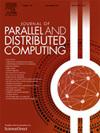ConCeal: A Winograd convolution code template for optimising GCU in parallel
IF 3.4
3区 计算机科学
Q1 COMPUTER SCIENCE, THEORY & METHODS
引用次数: 0
Abstract
By minimising arithmetic operations, Winograd convolution substantially reduces the computational complexity of convolution, a pivotal operation in the training and inference stages of Convolutional Neural Networks (CNNs). This study leverages the hardware architecture and capabilities of Shanghai Enflame Technology's AI accelerator, the General Computing Unit (GCU). We develop a code template named ConCeal for Winograd convolution with 3 × 3 kernels, employing a set of interrelated optimisations, including task partitioning, memory layout design, and parallelism. These optimisations fully exploit GCU's computing resources by optimising dataflow and parallelizing the execution of tasks on GCU cores, thereby enhancing Winograd convolution. Moreover, the integrated optimisations in the template are efficiently applicable to other operators, such as max pooling. Using this template, we implement and assess the performance of four Winograd convolution operators on GCU. The experimental results showcase that Conceal operators achieve a maximum of 2.04× and an average of 1.49× speedup compared to the fastest GEMM-based convolution implementations on GCU. Additionally, the ConCeal operators demonstrate competitive or superior computing resource utilisation in certain ResNet and VGG convolution layers when compared to cuDNN on RTX2080.
一个Winograd卷积代码模板,用于并行优化GCU
通过最小化算术运算,Winograd卷积大大降低了卷积的计算复杂度,卷积是卷积神经网络(cnn)训练和推理阶段的关键操作。本研究利用了上海恩焰科技人工智能加速器通用计算单元(GCU)的硬件架构和功能。我们开发了一个名为“隐藏”的代码模板,用于3x3内核的Winograd卷积,采用了一组相关的优化,包括任务分区、内存布局设计和并行性。这些优化充分利用了GCU的计算资源,优化了数据流,并在GCU核心上并行执行任务,从而增强了Winograd卷积。此外,模板中的集成优化可以有效地应用于其他操作,例如最大池。使用该模板,我们在GCU上实现并评估了四个Winograd卷积算子的性能。实验结果表明,与GCU上最快的基于gem的卷积实现相比,隐蔽算子的最大加速速度为2.04倍,平均加速速度为1.49倍。此外,与RTX2080上的cuDNN相比,在某些ResNet和VGG卷积层中,hide运算符显示出具有竞争力或更高的计算资源利用率。
本文章由计算机程序翻译,如有差异,请以英文原文为准。
求助全文
约1分钟内获得全文
求助全文
来源期刊

Journal of Parallel and Distributed Computing
工程技术-计算机:理论方法
CiteScore
10.30
自引率
2.60%
发文量
172
审稿时长
12 months
期刊介绍:
This international journal is directed to researchers, engineers, educators, managers, programmers, and users of computers who have particular interests in parallel processing and/or distributed computing.
The Journal of Parallel and Distributed Computing publishes original research papers and timely review articles on the theory, design, evaluation, and use of parallel and/or distributed computing systems. The journal also features special issues on these topics; again covering the full range from the design to the use of our targeted systems.
 求助内容:
求助内容: 应助结果提醒方式:
应助结果提醒方式:


